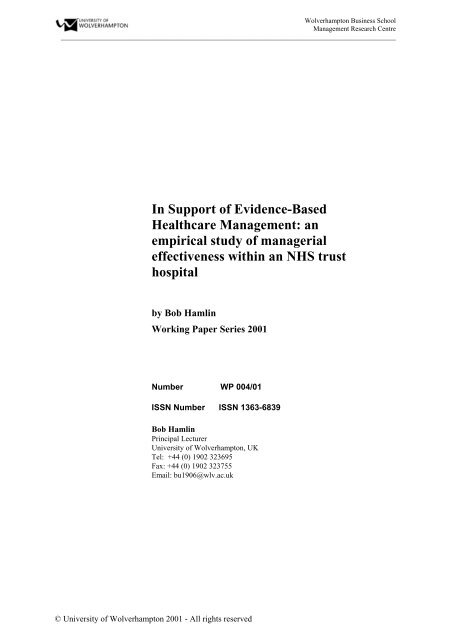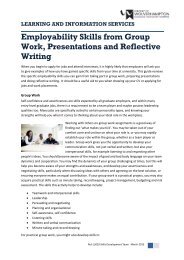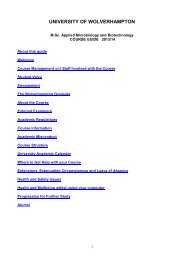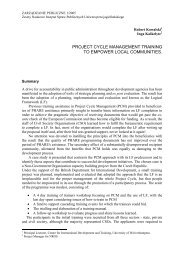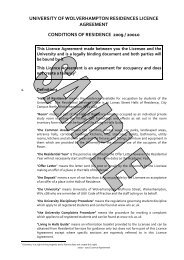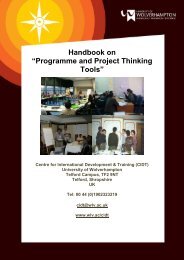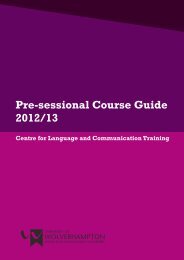In Support of Evidence-Based Healthcare Management: an ...
In Support of Evidence-Based Healthcare Management: an ...
In Support of Evidence-Based Healthcare Management: an ...
- No tags were found...
Create successful ePaper yourself
Turn your PDF publications into a flip-book with our unique Google optimized e-Paper software.
Wolverhampton Business School<strong>M<strong>an</strong>agement</strong> Research Centre__________________________________________________________________________________________________<strong>In</strong> <strong>Support</strong> <strong>of</strong> <strong>Evidence</strong>-<strong>Based</strong><strong>Healthcare</strong> <strong>M<strong>an</strong>agement</strong>: <strong>an</strong>empirical study <strong>of</strong> m<strong>an</strong>agerialeffectiveness within <strong>an</strong> NHS trusthospitalby Bob HamlinWorking Paper Series 2001Number WP 004/01ISSN Number ISSN 1363-6839Bob HamlinPrincipal LecturerUniversity <strong>of</strong> Wolverhampton, UKTel: +44 (0) 1902 323695Fax: +44 (0) 1902 323755Email: bu1906@wlv.ac.uk© University <strong>of</strong> Wolverhampton 2001 - All rights reserved
<strong>In</strong> <strong>Support</strong> <strong>of</strong> <strong>Evidence</strong>-<strong>Based</strong> <strong>Healthcare</strong> <strong>M<strong>an</strong>agement</strong>_________________________________________________________________________________________Copyright© University <strong>of</strong> Wolverhampton 2001All rights reserved. No part <strong>of</strong> this work may be reproduced, photocopied, recorded, stored in aretrieval system or tr<strong>an</strong>smitted, in <strong>an</strong>y form or by <strong>an</strong>y me<strong>an</strong>s, without the prior permission <strong>of</strong> thecopyright holder.The <strong>M<strong>an</strong>agement</strong> Research Centre is the co-ordinating centre for research activity withinWolverhampton Business School. This working paper series provides a forum for dissemination<strong>an</strong>d discussion <strong>of</strong> research in progress within the School. For further information contact:<strong>M<strong>an</strong>agement</strong> Research CentreWolverhampton Business SchoolTelford, Shropshire TF2 9NT!01902 321772 Fax 01902 321777The Working Paper Series is edited by Kate Gilbert2 <strong>M<strong>an</strong>agement</strong> Research Centre 2001
<strong>In</strong> <strong>Support</strong> <strong>of</strong> <strong>Evidence</strong>-<strong>Based</strong> <strong>Healthcare</strong> <strong>M<strong>an</strong>agement</strong>_________________________________________________________________________________________AbstractThis paper presents arguments in support <strong>of</strong> evidence-based healthcare m<strong>an</strong>agement, drawing onorg<strong>an</strong>isationally based empirical research, set within <strong>an</strong> NHS Trust Hospital in the UK. The researchfocuses on identifying the criteria <strong>of</strong> m<strong>an</strong>agerial effectiveness applying at the middle <strong>an</strong>d front linem<strong>an</strong>agement levels <strong>of</strong> the org<strong>an</strong>isation, using critical incident technique <strong>an</strong>d factor <strong>an</strong>alysis methods.It appears that the self-perceptions <strong>of</strong> m<strong>an</strong>agers <strong>an</strong>d the perceptions <strong>of</strong> their superiors <strong>an</strong>d subordinatesare very similar, <strong>an</strong>d only differ on a limited number <strong>of</strong> criteria. This challenges the ‘perspectivespecific’models <strong>of</strong> m<strong>an</strong>agerial effectiveness advocated by some researchers. The results arecompared against those from <strong>an</strong> equivalent study carried out within one part <strong>of</strong> HM Customs &Excise, a major department <strong>of</strong> the British Civil Service. The findings suggest the existence <strong>of</strong>generalised criteria <strong>of</strong> m<strong>an</strong>agerial effectiveness, supporting the notion <strong>of</strong> the ‘universally effectivem<strong>an</strong>ager’. This challenges the ‘contingent models’ <strong>of</strong> m<strong>an</strong>agerial effectiveness adopted by otherresearchers. <strong>In</strong> addition, the research makes a subst<strong>an</strong>tial contribution to the empirical base requiredto support the current drive towards establishing evidence-based m<strong>an</strong>agement within the healthcaresector.3 <strong>M<strong>an</strong>agement</strong> Research Centre 2001
<strong>In</strong> <strong>Support</strong> <strong>of</strong> <strong>Evidence</strong>-<strong>Based</strong> <strong>Healthcare</strong> <strong>M<strong>an</strong>agement</strong>_________________________________________________________________________________________The authorBob HamlinBob Hamlin is a Principal Lecturer in Hum<strong>an</strong> Resource Development within WolverhamptonBusiness School. His major research interest is m<strong>an</strong>agement effectiveness.AcknowledgementsThe author wishes to acknowledge the assist<strong>an</strong>ce <strong>of</strong> Dr. Fiona Campbell <strong>an</strong>d Richard Jubb inthis study, <strong>an</strong>d also the support <strong>an</strong>d active participation <strong>of</strong> the Personnel Director <strong>an</strong>dPersonnel Officer <strong>of</strong> the NHS Trust Hospital.4 <strong>M<strong>an</strong>agement</strong> Research Centre 2001
<strong>In</strong> <strong>Support</strong> <strong>of</strong> <strong>Evidence</strong>-<strong>Based</strong> <strong>Healthcare</strong> <strong>M<strong>an</strong>agement</strong>_________________________________________________________________________________________<strong>In</strong> <strong>Support</strong> <strong>of</strong> <strong>Evidence</strong>-<strong>Based</strong> <strong>Healthcare</strong> <strong>M<strong>an</strong>agement</strong>: <strong>an</strong>empirical study <strong>of</strong> m<strong>an</strong>agerial effectiveness within <strong>an</strong> NHStrust hospital<strong>In</strong>troductionThis paper describes the findings <strong>of</strong> <strong>an</strong> org<strong>an</strong>isationally-based collaborative research project designedto identify the criteria <strong>of</strong> m<strong>an</strong>agerial effectiveness applying within <strong>an</strong> acute National Health Service(NHS) Trust Hospital, situated near Wolverhampton in the West Midl<strong>an</strong>ds, Engl<strong>an</strong>d, UK. The studybuilds upon similar research conducted by Hamlin (1988) within UK secondary schools, <strong>an</strong>d byHamlin <strong>an</strong>d Reidy (1997) within HM Customs & Excise, which is a major department <strong>of</strong> the BritishCivil Service. The study complements those <strong>of</strong> Fl<strong>an</strong>ag<strong>an</strong> (1990) <strong>an</strong>d Alimo-Metcalfe (1998) whohave also researched m<strong>an</strong>agerial/leadership effectiveness within the NHS. However, whereas thework <strong>of</strong> these latter researchers focused predomin<strong>an</strong>tly upon general m<strong>an</strong>agers <strong>an</strong>d members <strong>of</strong> topm<strong>an</strong>agement teams, the study reported here is concerned mainly with middle, junior <strong>an</strong>d first linem<strong>an</strong>agers.The research lends support to the concept <strong>of</strong> evidence-based m<strong>an</strong>agement which is beginning to beestablished within healthcare settings. Furthermore, the focus <strong>an</strong>d design <strong>of</strong> the study address some <strong>of</strong>the gaps found in m<strong>an</strong>y other empirical research studies on m<strong>an</strong>agerial <strong>an</strong>d leadership effectiveness,including those conducted in healthcare settings as identified, for example, by Shipper (1991),Shipper et al (1998), Shipper & White (1999) <strong>an</strong>d V<strong>an</strong> Der Velde et al (1999).The contextOver the past ten years or so evidence-based practice has become well established within medicineboth in Europe <strong>an</strong>d North America (McMaster University <strong>Evidence</strong>-based Medicine Working Group,1992; Stetler et al, 1998; Sackett et al, 1996; Gray, 1997). Starting from the early calls <strong>of</strong> Cochr<strong>an</strong>e(1972) for greater effectiveness <strong>an</strong>d efficiency within the National Health Service (NHS) in GreatBritain, evidence-based approaches to practice are now being applied not only in medicine but also inother healthcare pr<strong>of</strong>essions such as therapy, nursing, mental health <strong>an</strong>d child care. However, havingexplored in depth the various debates <strong>an</strong>d interpretations <strong>of</strong> the definitions <strong>of</strong> <strong>Evidence</strong>-<strong>Based</strong>Medicine (EBM) <strong>an</strong>d arrived at a common underst<strong>an</strong>ding, Bury <strong>an</strong>d Mead (1998) have provided aclearer working definition for evidence-based practice in other areas <strong>of</strong> healthcare th<strong>an</strong> the EBMdefinition <strong>of</strong>fered by Sackett et al (1996). They consider the following definition more helpful totherapists adopting evidence-based approaches to practice in the broader field <strong>of</strong> healthcare:<strong>Evidence</strong>-based practice is the conscientious, explicit <strong>an</strong>d judicious use <strong>of</strong> current best evidencein making decisions about the care <strong>of</strong> individual patients, integrating individual clinicalexpertise with the best available external clinical evidence from systematic research.From <strong>an</strong> Americ<strong>an</strong> perspective on the application <strong>of</strong> evidence-based practice <strong>an</strong>d the role <strong>of</strong> nursingleadership in a particular healthcare setting, Stetler et al (1998) found that in reality <strong>of</strong>ten “the bestevidence <strong>of</strong> well-established research findings was not available to subst<strong>an</strong>tiate various clinical,m<strong>an</strong>agerial or educational decisions”. Hence, in a similar way to Bury <strong>an</strong>d Mead (1998), they haveproduced a helpful summary definition “as part <strong>of</strong> [their] realistic goal to enh<strong>an</strong>ce pr<strong>of</strong>essional,evidence-based nursing practice” as follows:<strong>Evidence</strong>-based nursing de-emphasises ritual, isolated <strong>an</strong>d unsystematic clinical experiences,ungrounded opinions <strong>an</strong>d tradition as a basis for nursing practices........ <strong>an</strong>d stresses instead theuse <strong>of</strong> research findings <strong>an</strong>d, as appropriate, quality improvement data, other operational <strong>an</strong>devaluation data, the consensus <strong>of</strong> recognised experts <strong>an</strong>d affirmed experience to subst<strong>an</strong>tiate5 <strong>M<strong>an</strong>agement</strong> Research Centre 2001
<strong>In</strong> <strong>Support</strong> <strong>of</strong> <strong>Evidence</strong>-<strong>Based</strong> <strong>Healthcare</strong> <strong>M<strong>an</strong>agement</strong>_________________________________________________________________________________________practice....... inherent to evidence-based practice are critical thinking <strong>an</strong>d research utilisationcompetencies.... <strong>an</strong>d the ability to use research as a process.Just as Stetler et al (1998) view evidence-based practice as applying to m<strong>an</strong>agerial <strong>an</strong>d educationaldecisions as well as to clinical decisions, Bury <strong>an</strong>d Mead (1998) claim that evidence-based healthcarein Britain goes beyond EBM. Its scope includes evidence-based commissioning/purchasing,evidence-based policy, evidence-based patient choice <strong>an</strong>d evidence-based m<strong>an</strong>agement.Various calls for evidence-based m<strong>an</strong>agement have been made in the British literature. For example,although evidence-based medicine c<strong>an</strong> draw on more clear-cut scientific research th<strong>an</strong> that availablein the field <strong>of</strong> m<strong>an</strong>agement, Rosemary Stewart (1998) argues it is still desirable to practice evidencebasedm<strong>an</strong>agement. To her, <strong>Evidence</strong>-<strong>Based</strong> <strong>M<strong>an</strong>agement</strong> is <strong>an</strong> attitude <strong>of</strong> mind which:-thinks in terms <strong>of</strong> evidence for decisions <strong>an</strong>d about the nature <strong>of</strong> the evidence-asks questions such as “What is happening?, How is it happening? Why? <strong>an</strong>d What are theconsequences?”-is aware <strong>of</strong> the potential limitations <strong>of</strong> the different <strong>an</strong>swers-is interested in research to try to find the <strong>an</strong>swers or at least to reduce the ignor<strong>an</strong>ce.She suggests m<strong>an</strong>agers need to build a questioning approach into their everyday m<strong>an</strong>agement practice<strong>an</strong>d encourage the creation <strong>of</strong> a research culture. However, to develop a research culture requires atleast one senior m<strong>an</strong>ager to act as a role model.With regard to evidence-based m<strong>an</strong>agement, Axelsson (1998) points out, from a broader Europe<strong>an</strong>perspective, that in m<strong>an</strong>y healthcare org<strong>an</strong>isations where large-scale org<strong>an</strong>isational <strong>an</strong>d m<strong>an</strong>agerialch<strong>an</strong>ges have taken place, physici<strong>an</strong>s have started to ask for empirical evidence on the efficiency <strong>an</strong>deffectiveness <strong>of</strong> the different org<strong>an</strong>isational models introduced. Drawing on the work <strong>of</strong> Ham et al(1995) he notes that m<strong>an</strong>y healthcare m<strong>an</strong>agers <strong>an</strong>d politici<strong>an</strong>s are asking for more scientificknowledge upon which to make their decisions on org<strong>an</strong>isational design. Hence he strongly promotesthe idea <strong>of</strong> <strong>an</strong> evidence-based approach to healthcare m<strong>an</strong>agement in order to improve its practice aswell as to stimulate research on the org<strong>an</strong>isation <strong>an</strong>d m<strong>an</strong>agement <strong>of</strong> healthcare. Referring to thework <strong>of</strong> Altm<strong>an</strong> (1994), he draws attention to the fact that the practice <strong>of</strong> EBM has exposed variousgaps in the medical knowledge base, with a large proportion <strong>of</strong> published medical research lackingeither relev<strong>an</strong>ce or sufficient methodological rigour to be reliable enough to <strong>an</strong>swer clinical questions.However, the identification <strong>of</strong> such gaps has been helpful in cumulatively generating new medicalresearch, which has continuously improved the practice <strong>of</strong> medicine. Encouraged by this, he claimsthat the evidence-based approach c<strong>an</strong> be applied to the practice <strong>of</strong> m<strong>an</strong>agement in general <strong>an</strong>d tohealthcare m<strong>an</strong>agement in particular. However, there needs to be some modification in approach fortwo main reasons. Firstly, because there are import<strong>an</strong>t methodological differences between medicalresearch <strong>an</strong>d m<strong>an</strong>agement research, the former being qu<strong>an</strong>titative <strong>an</strong>d empirical in character with thelatter being more qualitative <strong>an</strong>d phenomenological, <strong>an</strong>d secondly, because <strong>of</strong> the signific<strong>an</strong>tdifferences <strong>an</strong>d variability in the educational <strong>an</strong>d pr<strong>of</strong>essional backgrounds <strong>of</strong> m<strong>an</strong>agers compared tophysici<strong>an</strong>s. Taking these differences into consideration Axelsson (1998) takes <strong>Evidence</strong>-<strong>Based</strong><strong>M<strong>an</strong>agement</strong> as me<strong>an</strong>ing:m<strong>an</strong>agers should examine the scientific basis for their practice by learning to search <strong>an</strong>dcritically appraise empirical evidence from m<strong>an</strong>agement research as a basis for their decisions.This me<strong>an</strong>s they should be asking m<strong>an</strong>y questions, such as:What do we know empirically about different aspects <strong>of</strong> org<strong>an</strong>isation <strong>an</strong>d m<strong>an</strong>agement? Whatis the scientific state <strong>of</strong> this knowledge? What is the effectiveness <strong>an</strong>d efficiency <strong>of</strong> differentmodels <strong>of</strong> m<strong>an</strong>agement? What is the experience <strong>of</strong> these models from different org<strong>an</strong>isations?6 <strong>M<strong>an</strong>agement</strong> Research Centre 2001
<strong>In</strong> <strong>Support</strong> <strong>of</strong> <strong>Evidence</strong>-<strong>Based</strong> <strong>Healthcare</strong> <strong>M<strong>an</strong>agement</strong>_________________________________________________________________________________________These questions are similar to those posed by Rosemary Stewart <strong>an</strong>d have import<strong>an</strong>t implications forboth m<strong>an</strong>agement practice <strong>an</strong>d m<strong>an</strong>agement research. For example <strong>Evidence</strong>-<strong>Based</strong> <strong>M<strong>an</strong>agement</strong>me<strong>an</strong>s that m<strong>an</strong>agers should be:looking for inspiration <strong>an</strong>d support for their decisions in the empirical evidence fromm<strong>an</strong>agement research instead <strong>of</strong> being influenced by popular fashion or the simplerecommendations <strong>of</strong> consult<strong>an</strong>ts <strong>an</strong>d m<strong>an</strong>agement gurus. This should lead to increasingdem<strong>an</strong>ds from m<strong>an</strong>agers for org<strong>an</strong>isational research in order to produce empirical evidenceupon which practical m<strong>an</strong>agement c<strong>an</strong> be based. It may also lead to a more applied orientationin org<strong>an</strong>isational research whereby m<strong>an</strong>agement researchers associate themselves more with thepractical problems <strong>of</strong> m<strong>an</strong>agement inside different org<strong>an</strong>isations, maintain closer contact withm<strong>an</strong>agement practice, <strong>an</strong>d communicate their findings in a more easily accessible <strong>an</strong>d usefulway.Recognising the practice <strong>of</strong> <strong>Evidence</strong>-<strong>Based</strong> <strong>M<strong>an</strong>agement</strong> needs time <strong>an</strong>d that m<strong>an</strong>y m<strong>an</strong>agers maysay they have no time to spare for it, Axelsson (1998) also points out that that is what m<strong>an</strong>yphysici<strong>an</strong>s said when EBM was first introduced. However, they found very soon that “they couldimprove the quality <strong>of</strong> their decisions so much [by adopting <strong>an</strong> EBM approach] that it was well worththe time <strong>an</strong>d effort”. Today evidence-based practice is a widespread feature <strong>of</strong> medical <strong>an</strong>d healthcarepractice both in America, C<strong>an</strong>ada, Britain <strong>an</strong>d m<strong>an</strong>y other Europe<strong>an</strong> countries, <strong>an</strong>d is beginning to beapplied also in healthcare m<strong>an</strong>agement <strong>an</strong>d healthcare education.However, although much research has been done in the field <strong>of</strong> m<strong>an</strong>agement, it is also the case thatfew studies have produced empirical results that c<strong>an</strong> be generalised beyond particular org<strong>an</strong>isationalsettings. For example, resulting from a wide r<strong>an</strong>ging historical search for a strong empirical base tosupport the concept <strong>of</strong> evidence-based m<strong>an</strong>agement in healthcare, Axelsson (1998) concluded thatafter nearly one hundred years <strong>of</strong> research on org<strong>an</strong>isation <strong>an</strong>d m<strong>an</strong>agement the practical knowledgein the field seems to be back almost on the same (very low) scientific level as when the researchstarted. As he observes, most <strong>of</strong> the empirical research programmes carried out have been casestudies <strong>of</strong> org<strong>an</strong>isations, projects or ch<strong>an</strong>ge processes with few yielding results that could begeneralised from one org<strong>an</strong>isation to <strong>an</strong>other. <strong>In</strong> m<strong>an</strong>y inst<strong>an</strong>ces the research appears to have become<strong>an</strong> end in itself with little relev<strong>an</strong>ce for practical m<strong>an</strong>agement. This criticism has more recently beenmade by other commentators. For example, in its call for papers on ‘Practitioner <strong>an</strong>d PracticegroundedResearch’ for a Special Research Forum for the 2001 Academy <strong>of</strong> <strong>M<strong>an</strong>agement</strong> Meeting inWashington, D.C., the Academy drew attention to the fact that “academic (m<strong>an</strong>agement) research isincreasingly criticized for being too narrow, method driven, not responsive to real org<strong>an</strong>izationalneeds, or simply irrelev<strong>an</strong>t relative to the dem<strong>an</strong>ds <strong>of</strong> a knowledge driven approach”. Drawing on theconclusions <strong>of</strong> Lowendahl & Rev<strong>an</strong>g (1998) it argues that these criticisms “reflect a need for theacademic community to explore new research methods <strong>an</strong>d processes”. This needs to be done byaddressing the ‘double hurdle’ <strong>of</strong> conducting academically rigorous <strong>an</strong>d relev<strong>an</strong>t m<strong>an</strong>agementresearch that is not just “expl<strong>an</strong>atory science concerned with knowing the ‘what’ <strong>of</strong> m<strong>an</strong>agement, butis also concerned with discovering the ‘how’ <strong>of</strong> m<strong>an</strong>agement through the production <strong>of</strong> m<strong>an</strong>agementknowledge in the context <strong>of</strong> application”. Furthermore, the Academy’s call was for papers onpractitioner <strong>an</strong>d practice grounded m<strong>an</strong>agement research that creatively used alternative approachesincluding qu<strong>an</strong>titative methods combined synergistically with qualitative methods.Although the empirical research presented in this article is based on a case study aimed atunderst<strong>an</strong>ding one aspect <strong>of</strong> org<strong>an</strong>isational life within <strong>an</strong> NHS trust hospital, namely the criteria <strong>of</strong>m<strong>an</strong>agerial effectiveness applying within that org<strong>an</strong>isation, the research has been designed <strong>an</strong>d carriedout with the intent <strong>of</strong> drawing out practical <strong>an</strong>d generalisable conclusions on the basis <strong>of</strong> results thathave been generated using both qualitative <strong>an</strong>d qu<strong>an</strong>titative methods in a synergistic way.Much research has been done over the past thirty years or so on m<strong>an</strong>agerial behaviour. However,most has been focused almost exclusively on the absolute or relative frequency <strong>of</strong> observed7 <strong>M<strong>an</strong>agement</strong> Research Centre 2001
<strong>In</strong> <strong>Support</strong> <strong>of</strong> <strong>Evidence</strong>-<strong>Based</strong> <strong>Healthcare</strong> <strong>M<strong>an</strong>agement</strong>_________________________________________________________________________________________behaviours, or on the amount <strong>of</strong> time devoted to particular activities, <strong>an</strong>d not to the identification <strong>an</strong>dquality <strong>of</strong> specific behaviours associated with either effective or ineffective m<strong>an</strong>agement <strong>an</strong>dleadership (Shipper, 1991; Yukl, 1994; Shipper & White, 1999). Furthermore, O’Driscoll et al (1991)found that the frequency <strong>of</strong> activities performed by m<strong>an</strong>agers is unrelated to the way subordinates ratem<strong>an</strong>agerial competence. For the purpose <strong>of</strong> this study it should be noted also that Shipper et al (1998)drew attention to the fact that not much m<strong>an</strong>agement research conducted to date has been focused onleadership skills (or behavioural competencies), <strong>an</strong>d little has been done to examine leaders (<strong>an</strong>dm<strong>an</strong>agers) in health care settings. <strong>In</strong> contrast the present study focuses primarily on identifying thosespecific m<strong>an</strong>agerial behaviours <strong>an</strong>d competencies exhibited within the healthcare sector that areperceived to be examples <strong>of</strong> effective <strong>an</strong>d ineffective m<strong>an</strong>agement. <strong>In</strong> part it complements the studies<strong>of</strong> Fl<strong>an</strong>ag<strong>an</strong> (1990) <strong>an</strong>d Alimo-Metcalfe (1998) who have also researched m<strong>an</strong>agerial/leadershipeffectiveness within the NHS. However, whereas the work <strong>of</strong> these researchers focusedpredomin<strong>an</strong>tly upon top <strong>an</strong>d senior m<strong>an</strong>agers, the study reported here was concerned mainly withmiddle, junior <strong>an</strong>d front line m<strong>an</strong>agers, as already mentioned.Basing their arguments on the work <strong>of</strong> writers such as Thornton (1980), Foti (1990), Shipper (1991),Bass <strong>an</strong>d Yammarino (1991), Atwater <strong>an</strong>d Yammarino (1992), <strong>an</strong>d Tsui <strong>an</strong>d Ashford (1994), it hasbeen suggested by V<strong>an</strong> Der Velde et al (1999) that the ways in which m<strong>an</strong>agers are perceived <strong>an</strong>devaluated by others are import<strong>an</strong>t determin<strong>an</strong>ts <strong>of</strong> m<strong>an</strong>agerial success. However, subordinates, peers,superiors <strong>an</strong>d self-perceptions <strong>of</strong>ten differ in their judgement <strong>of</strong> behaviours <strong>an</strong>d perceptionsconstituting m<strong>an</strong>agerial effectiveness. This conclusion is supported by Shipper (2000) whorecommends that m<strong>an</strong>agerial effectiveness should be examined from the perspective <strong>of</strong> both superiors<strong>an</strong>d subordinates. It so happens a multiple perspective was adopted for the present study.MethodThe research programme comprised three stages, as follows:Stage 1<strong>In</strong> this first phase <strong>of</strong> job <strong>an</strong>alysis, statements <strong>of</strong> specific behaviours <strong>an</strong>d behavioural dimensionscharacterising effective <strong>an</strong>d ineffective m<strong>an</strong>agement were generated using the well established Critical<strong>In</strong>cident Technique (CIT), as originated by Fl<strong>an</strong>ag<strong>an</strong> (1954) <strong>an</strong>d applied by Latham et al (1975) in theUSA <strong>an</strong>d by Hamlin (1988) <strong>an</strong>d Hamlin & Reidy (1997) in the UK. The definitions relating to theterms ‘incident’ <strong>an</strong>d ‘critical incident’ used to research effective <strong>an</strong>d ineffective m<strong>an</strong>agementperform<strong>an</strong>ce, within the context <strong>of</strong> the present study, were those originally established by Fl<strong>an</strong>ag<strong>an</strong> asfollows:• <strong>In</strong>cident <strong>an</strong>y observable hum<strong>an</strong> activity that is sufficiently complete in itself to permitinferences <strong>an</strong>d predictions to be made about the person performing the act.• Critical <strong>In</strong>cident where the purpose <strong>an</strong>d intent <strong>of</strong> the incident is seen to be clear <strong>an</strong>d itsconsequences sufficiently definite to leave little doubt concerning its effects.Effective m<strong>an</strong>agement perform<strong>an</strong>ce was defined as “behaviour which one would wish all m<strong>an</strong>agers toadopt if <strong>an</strong>d when faced with similar circumst<strong>an</strong>ces”. <strong>In</strong>effective m<strong>an</strong>agement perform<strong>an</strong>ce wasdefined as “behaviour which, if it occurred repeatedly or even once in certain circumst<strong>an</strong>ces mightcause one to begin to question or doubt the m<strong>an</strong>agerial ability <strong>of</strong> the particular m<strong>an</strong>ager observed inthat inst<strong>an</strong>ce”.Stage 1 involved interviewing 45 m<strong>an</strong>agers across 4 levels <strong>of</strong> the m<strong>an</strong>agement hierarchy excluding thesenior executives, plus 12 non-m<strong>an</strong>agers, in order to obtain examples <strong>of</strong> ‘effective’ <strong>an</strong>d ‘ineffective’m<strong>an</strong>agement perform<strong>an</strong>ce applying within the org<strong>an</strong>isation.8 <strong>M<strong>an</strong>agement</strong> Research Centre 2001
<strong>In</strong> <strong>Support</strong> <strong>of</strong> <strong>Evidence</strong>-<strong>Based</strong> <strong>Healthcare</strong> <strong>M<strong>an</strong>agement</strong>_________________________________________________________________________________________Each person was asked to describe five examples <strong>of</strong> ‘effective’ <strong>an</strong>d ‘ineffective’ m<strong>an</strong>agerial behaviourwhich they had personally observed within the preceding six months, <strong>an</strong>d which in hindsight, couldbe regarded as ‘critical incidents’.M<strong>an</strong>agers interviewed were not allowed to volunteer critical incidents (CIs) based on their ownm<strong>an</strong>agerial practice, but only those they had observed in the m<strong>an</strong>agement practice <strong>of</strong> other m<strong>an</strong>agers.<strong>In</strong> total 405 critical incidents were collected.Stage 2This phase concerned the creation <strong>an</strong>d administration <strong>of</strong> a Behavioural Item Questionnaire (BIQ)based on the Stage 1 findings. The process comprised, in the first inst<strong>an</strong>ce, a detailed sorting <strong>of</strong> theCIs which revealed degrees <strong>of</strong> overlap, duplication <strong>an</strong>d similarity <strong>of</strong> me<strong>an</strong>ing. Only those that werefound to be the same as or similar in me<strong>an</strong>ing to at least two other CIs gathered from different parts <strong>of</strong>the org<strong>an</strong>isation were used. Twenty eight CIs were considered unusable for a variety <strong>of</strong> reasons suchas lack <strong>of</strong> detail, suitability <strong>an</strong>d/or ‘critical’ element or being ‘single’ incidents. Ultimately 377 CIswere used to create the BIQ. Of these 161 were ‘positive’ examples <strong>of</strong> effective m<strong>an</strong>agement <strong>an</strong>d 216were ‘negative’ examples <strong>of</strong> ineffective m<strong>an</strong>agement. <strong>In</strong> developing the BIQ the CIs were examinedfor sameness or similarity <strong>of</strong> me<strong>an</strong>ing <strong>an</strong>d thereby grouped to create a set <strong>of</strong> discrete ‘positive’ <strong>an</strong>d‘negative’ behavioural items. Each behavioural item comprised a minimum <strong>of</strong> three <strong>an</strong>d up to amaximum <strong>of</strong> nine CIs with one being selected in most cases as a representative ‘verbatim’ statement<strong>of</strong> that particular critical behaviour. <strong>In</strong> some inst<strong>an</strong>ces, composite behavioural items were constructedfrom certain clusters <strong>of</strong> CIs. The BIQ so created comprised 55 discrete behavioural items to whichwere attached a 5-point Likert rating scale. Following a pilot exercise administering the BIQ theinstrument was reduced to 52 items with <strong>an</strong> equal bal<strong>an</strong>ce <strong>of</strong> ‘effective’(positive) <strong>an</strong>d ‘ineffective’(negative) behavioural statements (items).Stage 3This final stage involved establishing job dimensions <strong>an</strong>d identifying criteria <strong>of</strong> m<strong>an</strong>agerialeffectiveness through a process <strong>of</strong> reducing, classifying, <strong>an</strong>d grouping the effective <strong>an</strong>d ineffectivebehavioural items into behavioural categories. To avoid the possibility <strong>of</strong> subjective judgements <strong>of</strong>the researchers/job <strong>an</strong>alysts creeping into <strong>an</strong>d contaminating the research findings, it was decided touse a statistical method for exploring the relationships between the 52 behavioural items <strong>an</strong>d formaking sense <strong>of</strong> the large number <strong>of</strong> correlations between these variables. As in previous studiesSPSS factor <strong>an</strong>alysis was chosen for this purpose, <strong>an</strong>d, the particular method considered mostappropriate to secure a maximum number <strong>of</strong> extracted factors was ‘alpha factoring with varimaxrotation’. The BIQ was administered to three sets <strong>of</strong> people within the NHS trust hospital as follows:• M<strong>an</strong>agers <strong>an</strong>d non-m<strong>an</strong>agers who were asked to use the BIQ to rate their immediate line m<strong>an</strong>ager(Bottom up rating).• M<strong>an</strong>agers who were asked to rate themselves against the BIQ (Self rating).• M<strong>an</strong>agers, who were asked to rate a number <strong>of</strong> m<strong>an</strong>agers reporting directly to them, includingthose they considered on bal<strong>an</strong>ce their ‘most’ <strong>an</strong>d ‘least’ effective m<strong>an</strong>agers respectively (Topdown rating).A total <strong>of</strong> 44 ‘bottom up’, 64 ‘self rated’ <strong>an</strong>d 31 ‘top down’ BIQs were obtained <strong>an</strong>d subjected t<strong>of</strong>actor <strong>an</strong>alysis. The 26 positive items <strong>an</strong>d 26 negative items comprising the BIQ were separately‘alpha’ factor <strong>an</strong>alysed for each ‘bottom up’, ‘self rated’ <strong>an</strong>d ‘top down’ data set. This yieldedstatistically stable factorial solutions for all data sets except for the ‘top down’ negative items.However, by applying the ‘principal components’ method <strong>of</strong> factor <strong>an</strong>alysis stable solutions wereobtained for both positive <strong>an</strong>d negative items <strong>of</strong> this data set. Following the factoring process, thefactors so extracted were explored for me<strong>an</strong>ing <strong>an</strong>d given descriptive labels that described in essencethe nature <strong>an</strong>d classification <strong>of</strong> the respective behavioural items loaded onto each factor. Asdiscussed later, the result<strong>an</strong>t factorial solutions derived from each data set were very similar, thereby9 <strong>M<strong>an</strong>agement</strong> Research Centre 2001
<strong>In</strong> <strong>Support</strong> <strong>of</strong> <strong>Evidence</strong>-<strong>Based</strong> <strong>Healthcare</strong> <strong>M<strong>an</strong>agement</strong>_________________________________________________________________________________________mutually reinforcing the reliability <strong>an</strong>d validity <strong>of</strong> the results. What follows is a summary <strong>of</strong> thefindings from this empirical research on m<strong>an</strong>agerial effectiveness within the case study NHS trusthospital.The NHS Trust Hospital ResultsResults from ‘alpha’ factoring the ‘bottom up’ ratings <strong>of</strong> m<strong>an</strong>agersThe results from the ‘bottom up’ questionnaire whereby individuals including both m<strong>an</strong>agers <strong>an</strong>dnon-m<strong>an</strong>agers rated their own line m<strong>an</strong>agers are given in Table 1. Each <strong>of</strong> the factors are describedbelow with their associated factor loadings. The factor loading provides the extent to which the itemsreflect the nature <strong>of</strong> the construct. The percentage <strong>of</strong> vari<strong>an</strong>ce provides the expl<strong>an</strong>atory power <strong>of</strong> thefactor (note: according to Comrey (1973) a factor loading >0.71 is excellent; >0.63 is very good; >0.55 is good <strong>an</strong>d >0.45 is fair).10 <strong>M<strong>an</strong>agement</strong> Research Centre 2001
<strong>In</strong> <strong>Support</strong> <strong>of</strong> <strong>Evidence</strong>-<strong>Based</strong> <strong>Healthcare</strong> <strong>M<strong>an</strong>agement</strong>_________________________________________________________________________________________Table 1. ‘Alpha’ factorial solution from the ‘bottom up’ ratings <strong>of</strong> m<strong>an</strong>agersPOSITIVE BEHAVIOURSFactor 1: Org<strong>an</strong>isation, pl<strong>an</strong>ning & supportThis factor is concerned with being well org<strong>an</strong>ised, efficient <strong>an</strong>deffective; being good at pl<strong>an</strong>ning; thinking ahead <strong>an</strong>d developinglong term pl<strong>an</strong>s; <strong>an</strong>d also about supporting staff. The factorexplains 69% <strong>of</strong> the vari<strong>an</strong>ce <strong>an</strong>d the key items strongly loaded onto it were:• When faced with urgent problems, is good at making decisions,following them through <strong>an</strong>d keeping promises (0.794)• Runs meetings efficiently <strong>an</strong>d effectively (0.791)• Develops a long term department strategy <strong>an</strong>d pl<strong>an</strong> whichprovides clarity <strong>an</strong>d purpose (0.786)• Gives support to staff in developing their careers (0.768)• Thinks ahead <strong>an</strong>d makes sure things are done in good time <strong>an</strong>dprepares well (0.752)• Takes control <strong>of</strong> difficult situations <strong>an</strong>d deals with them quickly<strong>an</strong>d appropriately (0.631)Factor 2: Open & personal m<strong>an</strong>agement styleThis factor is about developing trust, listening, being open to staff<strong>an</strong>d adopting a personal approach. The factor explains 4% <strong>of</strong> thevari<strong>an</strong>ce <strong>an</strong>d comprises six key items as follows:• Gives time to listen to staff with problems or worries relative towork or personal issues (0.858)• Is approachable <strong>an</strong>d makes themselves readily available to staff(0.828)• Develops a sense <strong>of</strong> trust with staff (0.790)• Keeps staff <strong>an</strong>d colleagues regularly informed <strong>an</strong>d up to date onwhat is happening <strong>an</strong>d on matters directly affecting them (0.780)• Deals with difficult <strong>an</strong>d personal issues with sensitivity(0.779)• Gives staff the freedom/support to perform their own work in• the way they see fit within their area (0.716)NEGATIVE BEHAVIOURSFactor 1: Undermining <strong>an</strong>d dictatorial/autocraticbehaviourThis factor comprises two main str<strong>an</strong>ds, namelyundermining behaviour <strong>an</strong>d dictatorial/autocratic m<strong>an</strong>agerial style which indicate a lack<strong>of</strong> concern or consideration for staff <strong>an</strong>d/orcolleagues.The factor explains 61% <strong>of</strong> the vari<strong>an</strong>ce withnine strongly loaded items as follows:• Engages in bullying <strong>an</strong>d humiliates staff(0.819)• Undermines or dismisses the efforts <strong>of</strong> staff(0.750)• Exhibits m<strong>an</strong>ipulative, politicking <strong>an</strong>dundermining behaviour (0.727)• During meetings makes inappropriately <strong>of</strong>fh<strong>an</strong>d remarks or inappropriately voicesdisagreements in public (0.708)• Overrides colleague m<strong>an</strong>agers, goes behindthe back or over the heads <strong>of</strong> other m<strong>an</strong>agers(0.677)• Refuses to admit to his/her own mistakes orerrors in judgement (0.629)• Fails to fully underst<strong>an</strong>d the problems withthe department/unit or the complexities <strong>of</strong>situations at ground level (0.590)• Forces or imposes ch<strong>an</strong>ge upon peoplewithout consultation <strong>an</strong>d collaboration (0.579)• Is inconsistent or is unfair in their dealingswith people (0.558)Factor 2: Avoid<strong>an</strong>ce behaviourThis factor, which is to do with avoid<strong>an</strong>cebehaviour, has two str<strong>an</strong>ds. One concerns theignoring <strong>of</strong> rules, policies, procedures <strong>an</strong>dproblems, <strong>an</strong>d the other concerns avoidingresponsibilities <strong>an</strong>d giving sufficient time tothings.The factor explains 7% <strong>of</strong> the vari<strong>an</strong>ce withthe following key items loaded on to it:• Refuses to recognise problems or deadlines<strong>an</strong>d avoids making decisions or takingnecessary action (0.805)• When in meetings tends to parade <strong>an</strong>doveremphasise the negative views ratherth<strong>an</strong> the positive (0.790)• Gives insufficient time to <strong>an</strong>d/or isinsufficiently org<strong>an</strong>ised when h<strong>an</strong>dlingpaperwork (0.776)• Avoids or abdicates his/her responsibilities(0.704)• Ignores hospital policy/rules <strong>an</strong>d attemptsto bypass the system (0.644)• Fails to follow correct/appropriateprocedures (0.582)Factor 3: Failing to inform otherpeopleThis factor is primarily about failingto keep people informed, <strong>of</strong> beingopen <strong>an</strong>d forthright incommunications <strong>an</strong>d obtainingnecessary information.The factor explains 5% <strong>of</strong> thevari<strong>an</strong>ce. The following items arekey to the factor:• Neglects to inform own <strong>an</strong>d/orother staff <strong>of</strong> things that are goingto happen (0.866)• Fails to inform or notify the rightpeople at the right time (0.832)• Takes action before obtaining orchecking the necessaryinformation (0.682)• Fails to be honest, forthright <strong>an</strong>dupfront in their communications<strong>an</strong>d dealings with people (0.616)<strong>Based</strong> on the perceptions <strong>of</strong> subordinates this research suggests there are five criteria (factors)<strong>of</strong> m<strong>an</strong>agerial effectiveness, two being associated with m<strong>an</strong>agerial success <strong>an</strong>d three withm<strong>an</strong>agerial failure.Results from ‘alpha’ factoring the ‘self’ ratings <strong>of</strong> m<strong>an</strong>agersThis section describes in outline only the factors obtained by the factoring <strong>of</strong> the ‘self rated’ BIQ dataas set out in Table 2. However <strong>an</strong> indication is given as to the number <strong>of</strong> behavioural items (BIs)loaded onto each factor <strong>an</strong>d the r<strong>an</strong>ge <strong>of</strong> the respective factor loadings (FLs).11 <strong>M<strong>an</strong>agement</strong> Research Centre 2001
<strong>In</strong> <strong>Support</strong> <strong>of</strong> <strong>Evidence</strong>-<strong>Based</strong> <strong>Healthcare</strong> <strong>M<strong>an</strong>agement</strong>_________________________________________________________________________________________Table 2. ‘Alpha’ factorial solution from the ‘self’ ratings <strong>of</strong> m<strong>an</strong>agersPOSITIVE BEHAVIOURSFactor 1: Active supportiveleadershipThis factor is predomin<strong>an</strong>tly todo with being approachable,developing trust, h<strong>an</strong>dlingdifficult <strong>an</strong>d personal issueswith sensitivity, <strong>an</strong>d takingaction to help <strong>an</strong>d support staff.The factor explains 54% <strong>of</strong> thevari<strong>an</strong>ce.(BIs: 7 FLs: 0.758--0.522)NEGATIVE BEHAVIOURSFactor 1: Dictatorial/autocraticm<strong>an</strong>agement <strong>an</strong>d negativeapproachOverall this factor is concernedwith a general lack <strong>of</strong> concernor consideration for otherpeople. Behaviours reflectingbullying <strong>an</strong>d a threateningm<strong>an</strong>ner were key to this factor.The factor explains 54% <strong>of</strong> thevari<strong>an</strong>ce.(BIs: 7 FLs: 0.848--0.617)Factor 2: <strong>In</strong>clusive decisionmakingThis factor is concerned withinvolving staff in decisionmaking, listening to their ideas,c<strong>an</strong>vassing opinions, <strong>an</strong>dempowering them to make theirown decisions.The factor explains 5% <strong>of</strong> thevari<strong>an</strong>ce.(BIs: 5 FLs: 0.701--O.526)Factor 2: Not informing people<strong>an</strong>d exhibiting poor org<strong>an</strong>isationEssentially this factor is aboutfailing to inform, notify <strong>an</strong>dinstruct people. However, itemswere also related to poororg<strong>an</strong>isation <strong>an</strong>d prioritisation.The factor explains 8% <strong>of</strong> thevari<strong>an</strong>ce.(BIs: 6 FLs: 0.693--0.436)Factor 3: Org<strong>an</strong>isation <strong>an</strong>dpl<strong>an</strong>ningThis factor is primarilyconcerned with being wellorg<strong>an</strong>ised, efficient <strong>an</strong>deffective, <strong>an</strong>d also being good atpl<strong>an</strong>ning, thinking ahead <strong>an</strong>ddeveloping long term pl<strong>an</strong>s.The factor explains 4% <strong>of</strong> thevari<strong>an</strong>ce.(BIs: 5 FLs: 0.792--0.511)Factor 3: Ignoring <strong>an</strong>davoid<strong>an</strong>ce behaviourThis factor is about avoid<strong>an</strong>cebehaviour such as ignoringpolicies, rules <strong>an</strong>d procedures,bypassing systems, <strong>an</strong>d hidingfrom ones own mistakes.It explains 4% <strong>of</strong> the vari<strong>an</strong>ce.(BIs: 5 FLs: 0.739--0.554)Factor 4: Looking after theinterests <strong>an</strong>d needs <strong>of</strong> staffThis factor is about showingconcern for individuals bygiving them support for theirpersonal or career development;by effective delegation, bytaking a personal interest, <strong>an</strong>dby giving praise. It is also aboutmonitoring the collective needs<strong>of</strong> staff <strong>an</strong>d their department.This factor explains 3% <strong>of</strong> thevari<strong>an</strong>ce.(BIs: 6 FLs: 0.709--0.533)Factor 4: Self-serving oruncaring m<strong>an</strong>agementThis factor is essentiallyconcerned with achieving onesown aims <strong>an</strong>d interests throughm<strong>an</strong>ipulation <strong>an</strong>d politicking atthe expense <strong>of</strong> other people.The factor explains 3% <strong>of</strong> thevari<strong>an</strong>ce.(BIs: 3 FLs: 0.772--0.513)<strong>Based</strong> on the self perceptions <strong>of</strong> m<strong>an</strong>agers this research suggests there are eight criteria (factors) <strong>of</strong>m<strong>an</strong>agerial effectiveness with four associated with m<strong>an</strong>agerial success <strong>an</strong>d four with failure.Results from factoring the ‘top down’ ratings <strong>of</strong> m<strong>an</strong>agersThis section outlines the factors obtained from the ‘top down’ data.Table 3. ‘Alpha’ factorial solution from the ‘top down’ ratings <strong>of</strong> m<strong>an</strong>agersPOSITIVE BEHAVIOURSFactor 1: Pl<strong>an</strong>ning <strong>an</strong>dorg<strong>an</strong>isation /giving support tostaffThis factor has two str<strong>an</strong>ds, oneconcerned with being wellprepared , well org<strong>an</strong>ised <strong>an</strong>defficient; with thinking ahead,<strong>an</strong>d ensuring things are done ingood time. The other str<strong>an</strong>dconcerns giving physical <strong>an</strong>demotional help <strong>an</strong>d support tostaff.The factor explains 64% <strong>of</strong> thevari<strong>an</strong>ce(BIs: 7 FLs: 0.763—0.485)Factor 2: <strong>In</strong>clusive decisionmaking <strong>an</strong>d personal approachThis factor is primarilyconcerned with effectivedecision making where them<strong>an</strong>ager uses his/her resourceswell to aid in the process,gathers <strong>an</strong>d assesses all therelev<strong>an</strong>t facts, listens to theideas <strong>of</strong> staff , develops a sense<strong>of</strong> trust, <strong>an</strong>d adopts a personalapproachThe factor explains 6% <strong>of</strong> thevari<strong>an</strong>ce.(BIs: 5 FLs: 0.858—0.581)Factor 3: Empowerment <strong>an</strong>ddelegationThis factor is concerned withencouraging staff to workthrough their own problems,giving them the freedom <strong>an</strong>ddiscretion to make their owndecisions or be involved indecision making, <strong>an</strong>d toproactively delegate.The factor explains 4% <strong>of</strong> thevari<strong>an</strong>ce(BIs: 4 FLs: 0.774—0.511)Factor 4: <strong>In</strong>forming peopleThis factor is wholly concernedwith keeping people regularlyinformed <strong>an</strong>d up to date.The factor explains 3% <strong>of</strong> thevari<strong>an</strong>ce.(BIs: 1 FLs: 0.700)The results <strong>of</strong> the ‘alpha’ factoring <strong>of</strong> the ‘positive’ data based on the ‘top down’ perceptions <strong>of</strong>superiors suggests there are four criteria <strong>of</strong> m<strong>an</strong>agerial effectiveness associated with m<strong>an</strong>agementsuccess. As mentioned above a statistically stable solution could not be obtained from ‘alpha’factoring the ‘negative’ data. However, by applying the ‘principal components’ method both a‘positive’ <strong>an</strong>d ‘negative’ factorial solution were obtained as outlined in Table 4.Table 4. ‘Principal components’ factorial solutions from the ‘top down’ ratings <strong>of</strong> m<strong>an</strong>agers12 <strong>M<strong>an</strong>agement</strong> Research Centre 2001
<strong>In</strong> <strong>Support</strong> <strong>of</strong> <strong>Evidence</strong>-<strong>Based</strong> <strong>Healthcare</strong> <strong>M<strong>an</strong>agement</strong>_________________________________________________________________________________________POSITIVE BEHAVIOURSFactor 1: Org<strong>an</strong>isation & pl<strong>an</strong>ning/proactive, <strong>an</strong>d supportive leadershipThis factor is loaded with twodistinctive str<strong>an</strong>ds <strong>of</strong> m<strong>an</strong>agerialbehaviour. One comprises sevenbehavioural items all concerned witheffective org<strong>an</strong>isation <strong>an</strong>d pl<strong>an</strong>ning( BIs: 7 FLs: 0.94-0.720 )The other str<strong>an</strong>d also comprises sevenbehavioural items <strong>an</strong>d these all relateto different facets <strong>of</strong> a proactive,supportive <strong>an</strong>d peronal approach tom<strong>an</strong>agement <strong>an</strong>d leadership. Thefactor explains 66% <strong>of</strong> the vari<strong>an</strong>ce(BIs: 7 FLs: 0.863-0.617)NEGATIVE BEHAVIOURSFactor 1: Ignoring &avoiding behaviour/intimidating staffThis factor ispredomin<strong>an</strong>tly concernedwith ignoring <strong>an</strong>davoid<strong>an</strong>ce behavioursuch as ignoring policies,<strong>an</strong>d rules; failing t<strong>of</strong>ollow correctprocedures; not beingopen, honest <strong>an</strong>dforthright incommunications;avoiding responsibilities;<strong>an</strong>d refusing to admit toown mistakes. It is alsoto do with bullying,humiliating <strong>an</strong>dthreatening behaviours.The factor accounts for62% <strong>of</strong> the vari<strong>an</strong>ce.(BIs: 8 FLs: 0.876-0.724)Factor 2: Uncaring, selfserving m<strong>an</strong>agementfocus/undermining <strong>of</strong>othersThis factor comprisesm<strong>an</strong>agerial behavioursthat are, for example,concerned with beinginconsistent, unfair, nonsupportive, undermining<strong>an</strong>d dismissive <strong>of</strong> otherpeople <strong>an</strong>d their efforts,<strong>an</strong>d also m<strong>an</strong>ipulative orpoliticking in nature.The factor explains 9%<strong>of</strong> the vari<strong>an</strong>ce.(BIs: 4 FLs: 0.855-0.587)Factor 2: Empowers staff <strong>an</strong>d delegateseffectivelyThis factor is about m<strong>an</strong>agers encouraging staff toresolve their own problems, giving them thefreedom to work in ways they see fit, involvingthem in decision making <strong>an</strong>d being proactive <strong>an</strong>deffective in delegationThe factor explains 7% <strong>of</strong> the vari<strong>an</strong>ce.(BIs: 4 FLs: 0.879-0.595)Factor 3: <strong>In</strong>adequateflow <strong>an</strong>d use <strong>of</strong>informationThe factor is essentiallyabout failing to inform,notify or instruct staff<strong>an</strong>d not discussingmatters with them. It isalso about not obtainingor checking informationprior to action.The factor accounts for6% <strong>of</strong> the vari<strong>an</strong>ce(BIs:6 FLs: 0.872-0.355)Factor 3: <strong>In</strong>forming peopleThis factor is wholly concerned withkeeping people regularly informed <strong>an</strong>d up todate. The factor explains 5% <strong>of</strong> the vari<strong>an</strong>ce(BIs: 1 FLs: 0.908)Factor 4: Lack <strong>of</strong>concern for staffThis factor is aboutplacing unrealisticworkloads <strong>an</strong>d pressureson staff <strong>an</strong>d forcing orimposing ch<strong>an</strong>geswithout consultation.The factor explains 5%<strong>of</strong> the vari<strong>an</strong>ce.(BIs: 2 FLs: 0.888-0.789)Factor 5: Abdicatingfrom roles <strong>an</strong>dresponsibilitiesThe three behavioursloaded on to this factorare all concerned withdifferent kinds <strong>of</strong>abdicating from roles,responsibilities <strong>an</strong>d whatneeds to be done.The factor accounts for4% <strong>of</strong> the vari<strong>an</strong>ce.(BIs: 3 FLs: 0.837-0.617)<strong>Based</strong> on the perceptions <strong>of</strong> superiors the ‘principal components’ factoring solution suggests there areeight criteria (factors) <strong>of</strong> m<strong>an</strong>agerial effectiveness, three being associated with m<strong>an</strong>agement success<strong>an</strong>d five with failure.As c<strong>an</strong> be seen by comparing <strong>an</strong>d contrasting the positive ‘alpha’ <strong>an</strong>d ‘principal components’ factorialsolutions, there is a high degree <strong>of</strong> similarity in the two sets <strong>of</strong> extracted factors both in terms <strong>of</strong> thefactorial labels, <strong>an</strong>d, the type <strong>of</strong> m<strong>an</strong>agerial behaviours comprising these factors. This being the case,it has been considered both sound <strong>an</strong>d appropriate for the comparative <strong>an</strong>alysis discussed in thefollowing section, to use this stable negative ‘principal components’ solution in place <strong>of</strong> the desired‘alpha’ solution that could not be obtained.Results <strong>of</strong> comparing the ‘bottom up’, ‘self’ <strong>an</strong>d ‘top down’ factorial solutionsA comparison <strong>of</strong> the positive factors extracted by factoring the ‘bottom up’, ‘self ’ <strong>an</strong>d ‘top down’rated BIQ data’s respectively reveals a high degree <strong>of</strong> coincidence, sameness <strong>an</strong>d similarity betweenthe criteria (factors) <strong>of</strong> m<strong>an</strong>agerial effectiveness obtained. As c<strong>an</strong> be seen in Table 5 the judgments<strong>an</strong>d perceptions <strong>of</strong> m<strong>an</strong>agerial effectiveness <strong>an</strong>d ineffectiveness <strong>of</strong> m<strong>an</strong>agers themselves, theirsuperiors <strong>an</strong>d their subordinates, appear to have very much in common. Of the ten ‘positive’ criteriaonly three were specific to one perspective, namely ‘Looking after the interests <strong>an</strong>d needs <strong>of</strong> staff’which m<strong>an</strong>agers themselves perceived as a key criterion contributing to their own effectiveness, <strong>an</strong>d‘Empowerment & delegation’ <strong>an</strong>d ‘<strong>In</strong>forming people’ which were amongst the five ‘positive’ criteriaidentified from the perceptions <strong>of</strong> superiors.13 <strong>M<strong>an</strong>agement</strong> Research Centre 2001
<strong>In</strong> <strong>Support</strong> <strong>of</strong> <strong>Evidence</strong>-<strong>Based</strong> <strong>Healthcare</strong> <strong>M<strong>an</strong>agement</strong>_________________________________________________________________________________________A comparison <strong>of</strong> the ‘negative’ factors across all three data sets also reveals a high degree <strong>of</strong>similarity <strong>an</strong>d coincidence. Two <strong>of</strong> the five ‘top-down’ rated criteria, namely ‘Lack <strong>of</strong> concern forstaff ‘ <strong>an</strong>d ‘Abdicating from roles <strong>an</strong>d responsibilities’, appear to be completely perspective-specific,as do two str<strong>an</strong>ds <strong>of</strong> two <strong>of</strong> the ‘self’ rated criteria, namely ‘Negative approach’ <strong>an</strong>d ‘Exhibiting poororg<strong>an</strong>isation’.Table 5. Comparison <strong>of</strong> the ‘bottom up’, ‘self’ <strong>an</strong>d ‘top down’ rated criteria <strong>of</strong> m<strong>an</strong>agerialeffectivenessPOSITIVE FACTORSFactor ‘Bottom Up’ Rated Factor ‘Self’ Rated Factor ‘Top Down’ Rated1 Org<strong>an</strong>isation Pl<strong>an</strong>ning &<strong>Support</strong>ing2 Open & Personal <strong>M<strong>an</strong>agement</strong>Style1 Active <strong>Support</strong>ive Leadership 1 Pl<strong>an</strong>ning <strong>an</strong>dOrg<strong>an</strong>isation/Giving <strong>Support</strong> toStaff2 <strong>In</strong>clusive Decision Making 2 <strong>In</strong>clusive Decision making <strong>an</strong>dPersonal Approach3 Org<strong>an</strong>isation & Pl<strong>an</strong>ning 3 Empowerment <strong>an</strong>d Delegation4 Looking After the <strong>In</strong>terests <strong>an</strong>d 4 <strong>In</strong>forming PeopleNeeds <strong>of</strong> StaffNEGATIVE FACTORSFactor ‘Bottom Up’ Rated Factor ‘Self’ Rated Factor ‘Top Down’ Rated1 Undermining <strong>an</strong>dDictatorial/Autocratic Behaviour1 Dictatorial/Autocratic<strong>M<strong>an</strong>agement</strong> <strong>an</strong>d NegativeApproach1 Ignoring & AvoidingBehaviour/<strong>In</strong>timidating Staff2 Avoid<strong>an</strong>ce (Ignoring) Behaviour 2 Not <strong>In</strong>forming People/ Exhibiting 2 Uncaring, Self ServingPoor Org<strong>an</strong>isation<strong>M<strong>an</strong>agement</strong> Focus/Undermining<strong>of</strong> Others3 Failing to <strong>In</strong>form Other People 3 Avoid<strong>an</strong>ce (Ignoring) Behaviour 3 Not giving, receiving or using4 Self Serving & Uncaring<strong>M<strong>an</strong>agement</strong>information4 Lack <strong>of</strong> Concern for Staff5 Abdicating from Roles <strong>an</strong>dResponsibilitiesThese results in part support the findings <strong>of</strong> Atwater & Yammarino (1992) who found that superiors<strong>of</strong>ten appreciate <strong>an</strong>d value different behaviours to those <strong>of</strong> subordinates, <strong>an</strong>d <strong>of</strong> Foti (1990) who foundthat subordinates believed proactive m<strong>an</strong>agerial behaviour less import<strong>an</strong>t th<strong>an</strong> supervisors. From astudy <strong>of</strong> the literature V<strong>an</strong> Der Velde et al (1999) suggest subordinates, supervisors, peers <strong>an</strong>d selfperceptions<strong>of</strong>ten differ in their judgements <strong>of</strong> behaviour, which was confirmed from their ownresearch into middle m<strong>an</strong>agers’ perceptions <strong>of</strong> top m<strong>an</strong>agers versus top m<strong>an</strong>agers’ self-reports. Thiswas especially so with respect to activities generally being regarded import<strong>an</strong>t such as developingideas, motivating people, pl<strong>an</strong>ning <strong>an</strong>d decision making. <strong>In</strong> contrast, the present study suggests that avery strong common judgement exists between superiors, m<strong>an</strong>agers <strong>an</strong>d subordinates on what isimport<strong>an</strong>t in determining m<strong>an</strong>agerial effectiveness. All identified ‘Org<strong>an</strong>isation & pl<strong>an</strong>ning’ <strong>an</strong>d‘<strong>Support</strong>ing staff’ as key criteria <strong>of</strong> m<strong>an</strong>agerial effectiveness, whilst both superiors <strong>an</strong>d m<strong>an</strong>agersappear to value ‘<strong>In</strong>clusive decision making’ <strong>an</strong>d <strong>an</strong> ‘Open, personal approach or style’ to m<strong>an</strong>agingstaff. It should be noted, however, that the V<strong>an</strong> Der Velde et al (1999) study focused on middle <strong>an</strong>dtop m<strong>an</strong>agers in a large insur<strong>an</strong>ce comp<strong>an</strong>y, whereas the focus <strong>of</strong> this study was on non-m<strong>an</strong>agers/m<strong>an</strong>agers (bottom-up rated/subordinates’ perspective), front line m<strong>an</strong>agers/ middle m<strong>an</strong>agers (selfrated/m<strong>an</strong>agers’perspective) <strong>an</strong>d middle m<strong>an</strong>agers/top m<strong>an</strong>agers (top-down rated/superiors’perspective) in a healthcare setting. The results suggest several criteria <strong>of</strong> m<strong>an</strong>agerial effectivenesshave been applying within the NHS Trust Hospital in question, as given in Table 6.Table 6. Criteria <strong>of</strong> m<strong>an</strong>agerial effectiveness applying within the NHS trust hospitalPOSITIVE CRITERIAOrg<strong>an</strong>isation <strong>an</strong>d pl<strong>an</strong>ningActive supportive leadershipNEGATIVE CRITERIADictatorial/autocratic m<strong>an</strong>agement<strong>In</strong>timidating staff14 <strong>M<strong>an</strong>agement</strong> Research Centre 2001
<strong>In</strong> <strong>Support</strong> <strong>of</strong> <strong>Evidence</strong>-<strong>Based</strong> <strong>Healthcare</strong> <strong>M<strong>an</strong>agement</strong>_________________________________________________________________________________________Giving support to staffOpen <strong>an</strong>d personal m<strong>an</strong>agement approach or style<strong>In</strong>clusive decision makingLooking after the interests <strong>an</strong>d needs <strong>of</strong> staffEmpowerment & delegation<strong>In</strong>forming peopleNegative approachUndermining <strong>of</strong> othersAvoid<strong>an</strong>ce <strong>an</strong>d ignoring behaviourFailing to inform other peopleNot giving, receiving or using informationExhibiting poor org<strong>an</strong>isationSelf serving <strong>an</strong>d uncaring m<strong>an</strong>agementLack <strong>of</strong> concern for staffAbdicating roles <strong>an</strong>d responsibilitiesGeneralisability <strong>of</strong> the Research FindingsComparison with the HM Customs & Excise research on m<strong>an</strong>agerial effectivenessTo determine whether or not the NHS trust hospital criteria <strong>of</strong> m<strong>an</strong>agerial effectiveness are‘org<strong>an</strong>isational-specific’ or ‘universal’ a comparison has been made with criteria from a near identicalempirical research study carried out within the Anglia Collection <strong>of</strong> HM Customs & Excise, a majordepartment <strong>of</strong> the British Civil Service (Hamlin, Reidy & Stewart, 1998). Although a public sectororg<strong>an</strong>isation like the NHS, its ‘business’ <strong>an</strong>d ‘culture’ is radically different. The research focusedupon the m<strong>an</strong>agement task <strong>of</strong> middle m<strong>an</strong>agers (Higher Executive Officers-HEOs) <strong>an</strong>d first linem<strong>an</strong>agers (Executive Officers-EOs) who had within their respective roles signific<strong>an</strong>t amounts <strong>of</strong>responsibility for m<strong>an</strong>aging people. <strong>In</strong> the ‘Anglia’ study, over 130 m<strong>an</strong>agers in HEO <strong>an</strong>d EO roleswere interviewed <strong>an</strong>d over 1,200 critical incidents were collected <strong>an</strong>d used to create the BIQ. Thiswas administered to the HEOs <strong>an</strong>d EOs who were required not only to rate their immediatesubordinates (top down rated) but also themselves (self rated). Neither they, nor the non m<strong>an</strong>agerswho had taken part in the research, were asked to rate their immediate superiors (bottom up rating) ashad been the case in the NHS Trust Hospital research programme. The two sets <strong>of</strong> data from the BIQrating exercise were factor <strong>an</strong>alysed using alpha factoring with varimax rotation to extract bothpositive <strong>an</strong>d negative factors as shown in Table 7.15 <strong>M<strong>an</strong>agement</strong> Research Centre 2001
<strong>In</strong> <strong>Support</strong> <strong>of</strong> <strong>Evidence</strong>-<strong>Based</strong> <strong>Healthcare</strong> <strong>M<strong>an</strong>agement</strong>_________________________________________________________________________________________Table 7. Criteria <strong>of</strong> m<strong>an</strong>agerial effectiveness applying within HMCE: Anglia CollectionPOSITIVE CRITERIATop Down Rated Data1. Active supportive leadership2. Team orientation3. Proactive m<strong>an</strong>agement4. Effective delegation/empowerment5. Developing others(Training/coaching/mentoring)NEGATIVE CRITERIATop Down Rated Data1. Uncaring, self-serving, m<strong>an</strong>agement focus2. Toler<strong>an</strong>ce <strong>of</strong> poor perform<strong>an</strong>ce/low3. Lack <strong>of</strong> emotional control/adjustment4. Resist<strong>an</strong>ce to ch<strong>an</strong>ge <strong>an</strong>d abdicating responsibilities5. Autocratic/dictatorial m<strong>an</strong>agement(Lack <strong>of</strong> concern/consideration for staff)6. Depriving individuals <strong>of</strong> recognition, reward <strong>an</strong>ddevelopmental opportunitiesSelf Rated Data1. Empowering/communicating wide2. <strong>Support</strong>ive/participative leadership3. Proactive team leadership4. Active development <strong>of</strong> others(Training/coaching/mentoring)5. Proactive m<strong>an</strong>agement6. M<strong>an</strong>aging ch<strong>an</strong>geSelf Rated Data1. Exhibiting gradist behaviour2. Autocratic/dictatorial m<strong>an</strong>agement(Lack <strong>of</strong> concern/consideration for others)3. Narrow/parochial behaviour4. M<strong>an</strong>ipulative behaviour5. Lack <strong>of</strong> emotional control(M<strong>an</strong>ifesting extreme irrational behaviour)6. Irrational m<strong>an</strong>agement(Disorg<strong>an</strong>ised, political )7. Ignoring/over-riding needs <strong>of</strong> individuals <strong>an</strong>d org<strong>an</strong>isations8. Entrenched m<strong>an</strong>agement thinking9. Depriving individuals <strong>of</strong> support <strong>an</strong>d developmentalopportunities10. Being deliberately obstructive11. Passing the buck/inconsiderate to other teams12. Uncaring m<strong>an</strong>agementFrom a cursory gl<strong>an</strong>ce it c<strong>an</strong> be seen there are strong similarities between the findings <strong>of</strong> the twostudies, particularly between the sets <strong>of</strong> positive criteria. A comparative <strong>an</strong>alysis <strong>of</strong> the ‘self-rated’criteria, including the respective behavioural underpinnings, has revealed a very high degree <strong>of</strong>coincidence as c<strong>an</strong> be inferred from Table 8.16 <strong>M<strong>an</strong>agement</strong> Research Centre 2001
<strong>In</strong> <strong>Support</strong> <strong>of</strong> <strong>Evidence</strong>-<strong>Based</strong> <strong>Healthcare</strong> <strong>M<strong>an</strong>agement</strong>_________________________________________________________________________________________Table 8. Comparison <strong>of</strong> the ‘self rated’ criteria from the NHS trust hospital <strong>an</strong>d ‘Anglia’ studiesNHS Trust Hospital CriteriaPositiveActive supportive leadership<strong>In</strong>clusive decision makingOrg<strong>an</strong>isation <strong>an</strong>d pl<strong>an</strong>ningLooking after the interests/needs <strong>of</strong> staffHM Customs & Excise CriteriaPositive<strong>Support</strong>ive/participative leadershipProactive team leadershipEmpowering/communicating widelyProactive m<strong>an</strong>agementActive development <strong>of</strong> othersM<strong>an</strong>aging ch<strong>an</strong>geNegativeDictatorial/autocratic m<strong>an</strong>agementNegative approachNot informing peopleExhibiting poor org<strong>an</strong>isationAvoid<strong>an</strong>ce/ignoring behaviourSelf serving/uncaring m<strong>an</strong>agementNegativeAutocratic/dictatorial m<strong>an</strong>agementBeing deliberatively obstructiveEntrenched m<strong>an</strong>agement thinkingIrrational m<strong>an</strong>agement(Disorg<strong>an</strong>ised/political)IgnoringOveriding needs <strong>of</strong> individuals <strong>an</strong>d org<strong>an</strong>isationUncaring m<strong>an</strong>agement<strong>In</strong>considerate <strong>of</strong> other teams/Passing the buckNarrow parochial behaviourThe only criteria not in both sets <strong>of</strong> data is ‘M<strong>an</strong>aging ch<strong>an</strong>ge’ which is one <strong>of</strong> the six positivecriteria applying within the Anglia Collection <strong>of</strong> HMCE, <strong>an</strong>d ‘Not informing people’ which is one<strong>of</strong> the six negative criteria applying within the NHS Trust Hospital. This suggests that most <strong>of</strong> thecriteria <strong>of</strong> m<strong>an</strong>agerial effectiveness from both studies are capable <strong>of</strong> being generalised.A strong similarity <strong>an</strong>d coincidence also occurs between the ‘top down rated’ criteria as c<strong>an</strong> be seen inTable 9, though more so in terms <strong>of</strong> the negative criteria th<strong>an</strong> the positive. From these results itappears top m<strong>an</strong>agers in both org<strong>an</strong>isations perceived ‘Proactive m<strong>an</strong>agement <strong>an</strong>d leadership’including effective pl<strong>an</strong>ning <strong>an</strong>d org<strong>an</strong>isation, <strong>an</strong>d ‘Delegation <strong>an</strong>d empowerment’, <strong>an</strong>d ‘Givingsupport to staff’ as key determin<strong>an</strong>ts <strong>of</strong> m<strong>an</strong>agerial effectiveness. Whereas the top down raters in the‘Anglia’ study, m<strong>an</strong>y <strong>of</strong> whom were top m<strong>an</strong>agers, perceived one other key criterion <strong>of</strong> m<strong>an</strong>agerialeffectiveness, namely ‘Team orientation’, the top down raters in the NHS Trust Hospital studyidentified three additional criteria, namely ‘<strong>In</strong>clusive decision making’, ‘Personal approach tom<strong>an</strong>aging’, <strong>an</strong>d, ‘<strong>In</strong>forming people’.17 <strong>M<strong>an</strong>agement</strong> Research Centre 2001
<strong>In</strong> <strong>Support</strong> <strong>of</strong> <strong>Evidence</strong>-<strong>Based</strong> <strong>Healthcare</strong> <strong>M<strong>an</strong>agement</strong>_________________________________________________________________________________________Table 9. Comparison <strong>of</strong> the ‘top down’ criteria from the NHS trust <strong>an</strong>d ‘Anglia’ studiesNHS Trust Hospital CriteriaPositivePl<strong>an</strong>ning <strong>an</strong>d org<strong>an</strong>isationGiving support to staff<strong>In</strong>clusive decision makingHM Customs & Excise CriteriaPositiveProactive m<strong>an</strong>agement( <strong>In</strong>cludes being proactive in pl<strong>an</strong>ning <strong>an</strong>d org<strong>an</strong>ising )Active supportive leadershipDeveloping othersPersonal approachEmpowerment <strong>an</strong>d delegation<strong>In</strong>forming peopleNegativeEffective delegation <strong>an</strong>d empowermentTeam orientationNegativeIgnoring <strong>an</strong>d avoiding behaviour<strong>In</strong>timidating staffUncaring, self serving m<strong>an</strong>agement focusUndermining othersLack <strong>of</strong> emotional control/adjustmentUncaring, self serving m<strong>an</strong>agement focusDepriving individuals <strong>of</strong> recognition, reward <strong>an</strong>d developmentalopportunitiesNot giving, receiving or using informationLack <strong>of</strong> concern for staffAbdicating from roles <strong>an</strong>d responsibilitiesAutocratic/dictatorial m<strong>an</strong>agement(Lack <strong>of</strong> concern/consideration for staff)Abdicating responsibilitiesToler<strong>an</strong>ce <strong>of</strong> poor perform<strong>an</strong>ce/low st<strong>an</strong>dardsResist<strong>an</strong>ce to ch<strong>an</strong>geOf the seven negative criteria identified within the NHS Trust Hospital study, five are virtually thesame in terms <strong>of</strong> behavioural content <strong>an</strong>d me<strong>an</strong>ing as all <strong>of</strong> the seven negative criteria from the‘Anglia’ study, except for one. One could conclude from the comparison that the two other negativecriteria from the ‘NHS’ study are ‘org<strong>an</strong>isation-specific’, particularly because ‘Ignoring <strong>an</strong>d avoidingbehaviour’ <strong>an</strong>d ‘Not giving, receiving or using information’ would most likely be perceived as veryserious acts <strong>of</strong> m<strong>an</strong>agerial ineffectiveness within the work situation <strong>of</strong> <strong>an</strong> acute hospital, more so th<strong>an</strong>in m<strong>an</strong>y other org<strong>an</strong>isational settings. Although the negative criterion from the ‘Anglia’ study -‘Resist<strong>an</strong>ce to ch<strong>an</strong>ge’ - appears also to be ‘org<strong>an</strong>isation-specific’, it should be noted that ‘Resist<strong>an</strong>ceto ch<strong>an</strong>ge versus active innovative m<strong>an</strong>agement’ was one <strong>of</strong> seven ‘universal’ criteria <strong>of</strong> m<strong>an</strong>agerialeffectiveness resulting from a comparable empirical research study carried out previously by theauthor in UK Secondary Schools (Hamlin, 1988).DiscussionAs already outlined the Critical <strong>In</strong>cident Technique (CIT) was used to obtain from both m<strong>an</strong>agers <strong>an</strong>dnon m<strong>an</strong>agers specific examples <strong>of</strong> observed m<strong>an</strong>agerial behaviour which, at the time <strong>of</strong> theirobservations, were deemed by them to be examples <strong>of</strong> ‘effective’ or ‘ineffective’ m<strong>an</strong>agement.However only those that strictly fell within the definition <strong>of</strong> a critical incident as defined by Fl<strong>an</strong>ag<strong>an</strong>(1954) were used for the research study.By using the CIT method, the author believes this approach has addressed to a large extent thecriticisms <strong>of</strong> Shipper (1991), O’Driscoll et al (1991), Yukl (1994) <strong>an</strong>d Shipper <strong>an</strong>d White (1999) whohave expressed concerns about the soundness <strong>of</strong> m<strong>an</strong>agerial effectiveness criteria derived by some18 <strong>M<strong>an</strong>agement</strong> Research Centre 2001
<strong>In</strong> <strong>Support</strong> <strong>of</strong> <strong>Evidence</strong>-<strong>Based</strong> <strong>Healthcare</strong> <strong>M<strong>an</strong>agement</strong>_________________________________________________________________________________________researchers who have used approaches relying on the ‘absolute or relative frequency <strong>of</strong> observedbehaviours’ rather th<strong>an</strong> the ‘quality <strong>of</strong> specific behaviours’.The results <strong>of</strong> the NHS research reported in this article support to some degree the findings <strong>of</strong>Americ<strong>an</strong> researchers such as Shipper, (1991 & 2000), Atwater <strong>an</strong>d Yammarino (1992), Tsui <strong>an</strong>dAshford (1994) <strong>an</strong>d, <strong>of</strong> Europe<strong>an</strong> researchers such as V<strong>an</strong> Der Velde et al (1999), who argue that thejudgements <strong>an</strong>d perceptions <strong>of</strong> behaviour constituting m<strong>an</strong>agerial effectiveness <strong>of</strong> superiors <strong>an</strong>dsubordinates <strong>of</strong>ten differ from the self-perception <strong>an</strong>d judgement <strong>of</strong> m<strong>an</strong>agers themselves. Howeverthe differences in judgement that have emerged from the study are very limited in number across thefull r<strong>an</strong>ge <strong>of</strong> m<strong>an</strong>ager <strong>an</strong>d non m<strong>an</strong>ager perspectives. The vast majority <strong>of</strong> the criteria appear to beheld in common, not only within the two respective org<strong>an</strong>isations, but also between them. This pointsto a signific<strong>an</strong>t amount <strong>of</strong> generalisability <strong>of</strong> the identified criteria <strong>of</strong> m<strong>an</strong>agerial effectiveness.Over the past two decades there has been considerable debate <strong>an</strong>d controversy within the UKconcerning the notion <strong>of</strong> the ‘universally effective m<strong>an</strong>ager’. Some believe that “a set <strong>of</strong> universallyapplicable m<strong>an</strong>agement competence criteria - independent <strong>of</strong> function <strong>an</strong>d org<strong>an</strong>isational context” c<strong>an</strong>be derived as epitomised by the work <strong>of</strong> Boyatzis (Training Agency, 1988). Other expertcommentators such as John Burgoyne, have argued that this approach is misconceived <strong>an</strong>d “auniversal mech<strong>an</strong>ism is inappropriate” (Bennett & L<strong>an</strong>gford, 1983; Herriot, 1988; Smith et al 1989;Jacobs, 1989; Willcock, 1992; Hamlin & Stewart, 1998). <strong>In</strong> a similar vein Fl<strong>an</strong>ag<strong>an</strong> (1990) <strong>an</strong>dFl<strong>an</strong>ag<strong>an</strong> & Spurgeon (1996) assumed for their research into m<strong>an</strong>agerial effectiveness in the NHS thatm<strong>an</strong>agerial effectiveness is a subjective vision determined by factors within each org<strong>an</strong>isation, <strong>an</strong>dthat m<strong>an</strong>agerial competencies are situationally dependent, contingent upon the org<strong>an</strong>isational context<strong>an</strong>d therefore ‘org<strong>an</strong>isation-specific’. They argue that “for <strong>an</strong>y one org<strong>an</strong>isation there is merit inreinventing the wheel in terms <strong>of</strong> identifying the particular skills <strong>an</strong>d behaviours that are perceived bym<strong>an</strong>agers to represent effective m<strong>an</strong>agement in that org<strong>an</strong>isation at that time”, <strong>an</strong>d that “borrowingsets <strong>of</strong> words or competencies from <strong>an</strong>other org<strong>an</strong>isation, even a common set derived from a r<strong>an</strong>ge <strong>of</strong>org<strong>an</strong>isations, is only useful if they are debated in terms <strong>of</strong> me<strong>an</strong>ing <strong>an</strong>d value to the org<strong>an</strong>isation inquestion, <strong>an</strong>d then internalised <strong>an</strong>d operationalised by its m<strong>an</strong>agers”.However, the high degree <strong>of</strong> similarity, coincidence <strong>an</strong>d potential generalisability revealed by thepresent study challenge these ‘contingent’ <strong>an</strong>d ‘org<strong>an</strong>isation-specific’ models <strong>of</strong> m<strong>an</strong>agerialeffectiveness, <strong>an</strong>d point towards the existence <strong>of</strong> the ‘universally effective m<strong>an</strong>ager’ as reported byBennett & L<strong>an</strong>gford (1983) <strong>an</strong>d previously evidenced by Hamlin (1988). Although at the‘behavioural level’ m<strong>an</strong>y <strong>of</strong> the critical incidents <strong>an</strong>d behavioural items identified by the research areclearly specifically related in their detail to the org<strong>an</strong>isational setting <strong>of</strong> the NHS <strong>an</strong>d HM Customs &Excise respectively, <strong>an</strong>d at the ‘factorial level’ a number <strong>of</strong> the identified criteria <strong>of</strong> m<strong>an</strong>agerialeffectiveness are ‘org<strong>an</strong>isation-specific’ <strong>an</strong>d/or ‘perspective-specific’, the large majority <strong>of</strong> behaviours<strong>an</strong>d factors (criteria) are held in common across all perspectives <strong>an</strong>d between org<strong>an</strong>isations. Thissuggests these criteria possess ‘universal’ characteristics. Whilst at a behavioural level the researchlends a degree <strong>of</strong> support to the ‘contingent model <strong>of</strong> m<strong>an</strong>agerial effectiveness’ adopted by Fl<strong>an</strong>ag<strong>an</strong><strong>an</strong>d Spurgeon (1996), at the factorial level the results overall support more strongly the notion <strong>of</strong> the‘universally effective m<strong>an</strong>ager’. This challenges Fl<strong>an</strong>ag<strong>an</strong> <strong>an</strong>d Spurgeon’s view that there c<strong>an</strong> be ‘nosingle clear picture <strong>of</strong> effective m<strong>an</strong>agement or effective m<strong>an</strong>agers.’Limitation <strong>of</strong> the StudyOne limitation <strong>of</strong> the study is that it was undertaken in a single NHS Trust hospital. Therefore thecriteria <strong>of</strong> m<strong>an</strong>agerial effectiveness identified c<strong>an</strong>not yet be regarded categorically as generalised to<strong>an</strong>y population <strong>of</strong> healthcare m<strong>an</strong>agers beyond those in the study. Similar research needs to be carriedout in other types <strong>of</strong> NHS Trust healthcare settings including both acute <strong>an</strong>d community hospitals.However, the high degree <strong>of</strong> similarity <strong>an</strong>d coincidence revealed between the two studies suggestsm<strong>an</strong>y <strong>of</strong> the positive <strong>an</strong>d negative criteria identified are likely to be generalisable <strong>an</strong>d ‘universal’. Asecond limitation is the comparative lack <strong>of</strong> equivalent or near equivalent empirical case studyresearch in other org<strong>an</strong>isations <strong>an</strong>d other sectors against which to compare the findings.19 <strong>M<strong>an</strong>agement</strong> Research Centre 2001
<strong>In</strong> <strong>Support</strong> <strong>of</strong> <strong>Evidence</strong>-<strong>Based</strong> <strong>Healthcare</strong> <strong>M<strong>an</strong>agement</strong>_________________________________________________________________________________________ConclusionsSeveral conclusions c<strong>an</strong> be drawn from this research as follows:1. The positive criteria <strong>of</strong> m<strong>an</strong>agerial effectiveness point towards the r<strong>an</strong>ge <strong>an</strong>d type <strong>of</strong> m<strong>an</strong>agerialcompetencies that m<strong>an</strong>agers in the case study NHS Trust Hospital need to possess if they are tobe effective <strong>an</strong>d successful, whereas the negative criteria indicate the type <strong>of</strong> behaviours thatshould be avoided to prevent failure or being perceived as <strong>an</strong> ineffective m<strong>an</strong>ager2. The self perceptions <strong>of</strong> m<strong>an</strong>agers <strong>an</strong>d the perceptions <strong>of</strong> their superiors <strong>an</strong>d subordinatesconcerning what constitutes m<strong>an</strong>agerial effectiveness are very similar, <strong>an</strong>d differ on a limitednumber <strong>of</strong> criteria only.3. There are m<strong>an</strong>y similarities <strong>an</strong>d few differences between the findings from the two near identicalresearch studies carried out in the two very different public sector org<strong>an</strong>isations. This points to theexistence <strong>of</strong> generalised criteria <strong>of</strong> m<strong>an</strong>agerial effectiveness which support the notion <strong>of</strong> the‘universally effective m<strong>an</strong>ager’.4. The research could provide a sound basis for developing competence-based HR systems includingthe criteria required for effective perform<strong>an</strong>ce appraisal <strong>an</strong>d selection systems. The findingscould also be used to inform, shape <strong>an</strong>d evaluate m<strong>an</strong>agement development programmes ororg<strong>an</strong>isational ch<strong>an</strong>ge <strong>an</strong>d development initiatives.5. Despite the limitations outlined above the research <strong>of</strong>fers the potential for extending theempirical base required to support the development <strong>of</strong> evidence-based m<strong>an</strong>agement not onlywithin acute hospital settings such as the case study org<strong>an</strong>isation, but also within other healthcaresettings <strong>an</strong>d beyond.20 <strong>M<strong>an</strong>agement</strong> Research Centre 2001
<strong>In</strong> <strong>Support</strong> <strong>of</strong> <strong>Evidence</strong>-<strong>Based</strong> <strong>Healthcare</strong> <strong>M<strong>an</strong>agement</strong>_________________________________________________________________________________________ReferencesAxelsson, R.(1998) Towards <strong>an</strong> <strong>Evidence</strong> <strong>Based</strong> Health Care <strong>M<strong>an</strong>agement</strong> <strong>In</strong>ternational Journal <strong>of</strong>Health Pl<strong>an</strong>ning <strong>an</strong>d <strong>M<strong>an</strong>agement</strong> 13(4) pp. 307-317.Alimo-Metcalfe, B. (1998) The use <strong>of</strong> 360 degree feedback for leadership development <strong>In</strong>ternationalJournal <strong>of</strong> Selection <strong>an</strong>d Assessment 6(1) pp.35-44.Atwater, L. & Yammarino, F. (1992) Does self-other agreement on leadership perceptions moderatethe validity <strong>of</strong> leadership <strong>an</strong>d perform<strong>an</strong>ce predictions? Personnel Psychology 45(1) pp. 141-164.Altm<strong>an</strong>, D. G. (1994) The Sc<strong>an</strong>dal <strong>of</strong> Poor Medical Research British Medical Journal 308 pp. 283-284.Bass, B. & Yammarino, F. (1991) Congruence <strong>of</strong> self <strong>an</strong>d others’ leadership ratings <strong>of</strong> naval <strong>of</strong>ficersfor underst<strong>an</strong>ding successful perform<strong>an</strong>ce Applied Psychology: An <strong>In</strong>ternational Review 40(4) pp.437-454.Bennett, R. D. & L<strong>an</strong>gford, V. (1983) M<strong>an</strong>agerial Effectiveness, <strong>In</strong>: A. P. O. Williams (Ed) UsingPersonnel Research (Aldershot: Gower Press) pp. 61-84.Bury, T. & Mead, J. (1998) <strong>Evidence</strong>-based <strong>Healthcare</strong>: a practical guide for therapists (Oxford:Butterworth-Heinem<strong>an</strong>n).Cochr<strong>an</strong>e, A (1972) Effectiveness <strong>an</strong>d Efficiency: r<strong>an</strong>dom reflections on health services (London:Nuffield Trust).Comrey, A. L (1973) A first Course in Factor Analysis (London: Academic Press).Fl<strong>an</strong>ag<strong>an</strong>, H. (1990) A study <strong>of</strong> m<strong>an</strong>agerial effectiveness with particular reference to generalm<strong>an</strong>agers in the NHS, MSocSc ( ModeII Research) Thesis University <strong>of</strong> Birmingham.Fl<strong>an</strong>ag<strong>an</strong>, H. & Spurgeon, P. (1996) Public Sector M<strong>an</strong>agerial Effectiveness: theory <strong>an</strong>d practice inthe National Health Service (Buckingham: Open University Press).Fl<strong>an</strong>ag<strong>an</strong>, J. C. (1954) The Critical <strong>In</strong>cident Technique Psychological Bulletin 51 pp. 327-58.Foti, R. (1990) The role <strong>of</strong> cognitive categories in supervisor versus self-ratings, Paper presented atthe Annual Meeting <strong>of</strong> the Academy <strong>of</strong> <strong>M<strong>an</strong>agement</strong>, S<strong>an</strong> Fr<strong>an</strong>cisco, August.Gray, J. A. M. (1997) <strong>Evidence</strong>-based <strong>Healthcare</strong>: How to Make Health Policy <strong>an</strong>d <strong>M<strong>an</strong>agement</strong>Decisions (Edinburgh: Churchill Livingstone).Ham, C., Hunter, D. & Robinson, R.(1995) <strong>Evidence</strong>-based Policy Making British Medical Journal310 pp. 71-72.Hamlin, R. G (1988) The criteria <strong>of</strong> m<strong>an</strong>agerial effectiveness within secondary schools, CollectedOriginal Resources in Education 12(1) Published MPhil Thesis.Hamlin, R. G & Reidy, M (1997) Effecting Ch<strong>an</strong>ge in <strong>M<strong>an</strong>agement</strong> Culture Strategic Ch<strong>an</strong>geJournal Special Edition (December) pp. 435-450.Hamlin R. G., Reidy, M & Stewart, J. (1998) Bridging the HRD Research–Practice Gap throughPr<strong>of</strong>essional Partnerships Hum<strong>an</strong> Resource Development <strong>In</strong>ternational 1(3) pp. 273-290.Hamlin, R. G. & Stewart, J. (1998) <strong>In</strong> <strong>Support</strong> <strong>of</strong> <strong>Evidence</strong>-<strong>Based</strong> Hum<strong>an</strong> Resource DevelopmentPractice, Paper presented at the L<strong>an</strong>caster-Leeds Collaborative Conference: Emergent Fields in<strong>M<strong>an</strong>agement</strong>- Connecting Learning <strong>an</strong>d Critique Leeds University, July.Herriot, P. (1988) M<strong>an</strong>agerial Assessment: the research evidence, <strong>In</strong>: W. Hirsch & S. Bev<strong>an</strong> (Eds)What Makes a M<strong>an</strong>ager? <strong>In</strong> Search <strong>of</strong> a L<strong>an</strong>guage for <strong>M<strong>an</strong>agement</strong> Skills IMS Report No 144,<strong>In</strong>stitute <strong>of</strong> M<strong>an</strong>power Studies, University <strong>of</strong> Sussex.21 <strong>M<strong>an</strong>agement</strong> Research Centre 2001
<strong>In</strong> <strong>Support</strong> <strong>of</strong> <strong>Evidence</strong>-<strong>Based</strong> <strong>Healthcare</strong> <strong>M<strong>an</strong>agement</strong>_________________________________________________________________________________________Jacobs, R. (1989) Assessing <strong>M<strong>an</strong>agement</strong> Competences, Report <strong>of</strong> a Survey <strong>of</strong> Current Arr<strong>an</strong>gementsin the UK for the Assessment <strong>of</strong> <strong>M<strong>an</strong>agement</strong> Competences Berkhamstead, Ashridge <strong>M<strong>an</strong>agement</strong>Research Group, April.Latham, G. P, Wexley, K. N & R<strong>an</strong>d, T. M. (1975) The relev<strong>an</strong>ce <strong>of</strong> behavioural criteria developedfrom the critical incident technique C<strong>an</strong>adi<strong>an</strong> Journal <strong>of</strong> Behavioural Studies 17(4) pp. 349-358.Lowendahl, B. & Rev<strong>an</strong>g, O. (1998) Challenges to existing strategy theory in a post-industrial societyStrategic <strong>M<strong>an</strong>agement</strong> Journal 19(8) pp. 755-773.McMaster University, <strong>Evidence</strong>-<strong>Based</strong> Medicine Working Group (1992) <strong>Evidence</strong>-<strong>Based</strong> Medicine: <strong>an</strong>ew approach to teaching the practice <strong>of</strong> medicine JAMA 268 pp. 2420-2425.O’Driscoll, M., Humphries, M. & Larson, H. (1991) M<strong>an</strong>agerial Activities, Competence <strong>an</strong>dEffectiveness: M<strong>an</strong>agers <strong>an</strong>d Subordinate Perceptions <strong>In</strong>ternational Journal <strong>of</strong> Hum<strong>an</strong> Resource<strong>M<strong>an</strong>agement</strong> 2(3) pp. 313-326.Sackett, D., Rosenburg, D., Gray, J. A. M., Haynes, R. B. & Richardson, W. S. (1996) <strong>Evidence</strong><strong>Based</strong> Medicine: what it is <strong>an</strong>d what it isn’t British Medical Journal 312 pp. 71-72.Shipper, F. (1991) Mastery <strong>an</strong>d Frequency <strong>of</strong> M<strong>an</strong>agerial Behaviors Relative to Sub-unitEffectiveness Hum<strong>an</strong> Relations 44(4) pp. 371-388.Shipper, F. (2000) A Cross-Cultural , Multi-Dimensional, Nonlinear Examination <strong>of</strong> M<strong>an</strong>agerialSkills <strong>an</strong>d Effectiveness, A paper presented at the Academy <strong>of</strong> <strong>M<strong>an</strong>agement</strong> Meeting TorontoC<strong>an</strong>ada, August.Shipper, F, Pearson, D. A & Singer, D. (1998) A study <strong>an</strong>d comparative <strong>an</strong>alysis <strong>of</strong> effective <strong>an</strong>dineffective leadership skills <strong>of</strong> physici<strong>an</strong>s <strong>an</strong>d non-physici<strong>an</strong>s health care administrators HealthServices <strong>M<strong>an</strong>agement</strong> Research 11(2) pp. 124-135.Shipper, F. & White, C. S (1999) Mastery, frequency, <strong>an</strong>d interaction <strong>of</strong> m<strong>an</strong>agerial behaviours tosubunit effectiveness Hum<strong>an</strong> Relations 52(1) pp. 49-66.Smith, S. D., Pell, C., Jones, P., Slom<strong>an</strong>, M. & Blackwell, A. (1989) <strong>M<strong>an</strong>agement</strong> Challenge for the1990s <strong>M<strong>an</strong>agement</strong> Development Report on the Current Education, Training <strong>an</strong>d DevelopmentDebate in the UK commissioned by the Training Agency from Deloitte, Haskins <strong>an</strong>d Sells, July.Stetler, C., Brunell, M., Giuli<strong>an</strong>o, K., Morsi, D., Prince, L. & Newell-Stokes, V. (1998) <strong>Evidence</strong>-<strong>Based</strong> Practice <strong>an</strong>d the Role <strong>of</strong> Nursing Leadership Journal <strong>of</strong> Nursing Administration 28(7/8) pp.45-53.Stewart, R. (1998) More Art th<strong>an</strong> Science Health Service Journal 26 th March pp. 28-29.Thornton, G. (1980) Psychometric properties <strong>of</strong> self appraisals <strong>of</strong> job perform<strong>an</strong>ce PersonnelPsychology 33 pp. 263-271.Training Agency (1988) Classifying the components <strong>of</strong> m<strong>an</strong>agement competences, A Report by theOccupational St<strong>an</strong>dards Br<strong>an</strong>ch, September.Tsui, A. & Ashford, S. (1994) Adaptive Self-Regulation: a process view <strong>of</strong> m<strong>an</strong>agerial effectivenessJournal <strong>of</strong> <strong>M<strong>an</strong>agement</strong> 20(1) pp. 93-121.V<strong>an</strong> Der Velde, M., J<strong>an</strong>sen, P. & Vinkenburg, C. (1999) M<strong>an</strong>agerial Activities among Top <strong>an</strong>dMiddle m<strong>an</strong>agers: self versus other perceptions Journal <strong>of</strong> Applied <strong>M<strong>an</strong>agement</strong> Studies 8(2) pp.161-174.Willcock, S. G. (1992) M<strong>an</strong>agerial Effectiveness <strong>an</strong>d the Public Sector: a health service example<strong>In</strong>ternational Journal <strong>of</strong> Public Sector <strong>M<strong>an</strong>agement</strong> 5(5) pp. 4-10.Yukl, G. (1994) Leadership in Org<strong>an</strong>isations 3rd Edition (Englewood Cliffs: Prentice Hall).22 <strong>M<strong>an</strong>agement</strong> Research Centre 2001


